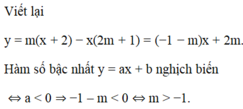tìm m để hàm số y=1/3x^3+(m-1)x+2 nghịch biến trên R
H24
Những câu hỏi liên quan
tìm các giá trị của m để hàm số sau
a) \(y=-x^3+\left(m+2\right)x^2-3x\) nghịch biến trên R
b) \(y=x^3-3x^2+\left(1-m\right)x\) đồng biến trên R
a: \(y=-x^3+\left(m+2\right)x^2-3x\)
=>\(y'=-3x^2+2\left(m+2\right)x-3\)
=>\(y'=-3x^2+\left(2m+4\right)\cdot x-3\)
Để hàm số nghịch biến trên R thì \(y'< =0\forall x\)
=>\(\left\{{}\begin{matrix}\left(2m+4\right)^2-4\cdot\left(-3\right)\left(-3\right)< =0\\-3< 0\end{matrix}\right.\)
=>\(4m^2+16m+16-4\cdot9< =0\)
=>\(4m^2+16m-20< =0\)
=>\(m^2+4m-5< =0\)
=>\(\left(m+5\right)\left(m-1\right)< =0\)
TH1: \(\left\{{}\begin{matrix}m+5>=0\\m-1< =0\end{matrix}\right.\)
=>\(\left\{{}\begin{matrix}m>=-5\\m< =1\end{matrix}\right.\)
=>-5<=m<=1
TH2: \(\left\{{}\begin{matrix}m+5< =0\\m-1>=0\end{matrix}\right.\)
=>\(\left\{{}\begin{matrix}m>=1\\m< =-5\end{matrix}\right.\)
=>\(m\in\varnothing\)
b: \(y=x^3-3x^2+\left(1-m\right)x\)
=>\(y'=3x^2-3\cdot2x+1-m\)
=>\(y'=3x^2-6x+1-m\)
Để hàm số đồng biến trên R thì \(y'>=0\forall x\)
=>\(\left\{{}\begin{matrix}\text{Δ}< =0\\a>0\end{matrix}\right.\)
=>\(\left\{{}\begin{matrix}3>0\\\left(-6\right)^2-4\cdot3\left(1-m\right)>=0\end{matrix}\right.\)
=>\(36-12\left(1-m\right)>=0\)
=>\(36-12+12m>=0\)
=>12m+24>=0
=>m+2>=0
=>m>=-2
Đúng 0
Bình luận (0)
Cho y=\(\frac{1}{3}mx^3-\left(m-1\right)x^2-3\left(m-2\right)x+\frac{1}{3}\)
a. Tìm m để hàm số đồng biến trên R
b. Tìm m để hàm số nghịch biến trên R
c. Tìm m để hàm số có 2 cực trị
d. Tìm m để hàm số có 2 cực trị x1,x2 sao cho x1+3x2=1
e. Tìm m để hàm số nghịch biến trên đoạn có độ dài bằng 1 (khi m>0)
Theo mình:
để hàm số đồng biến, đk cần là y'=0.
a>0 và \(\Delta'< 0\)
nghịch biến thì a<0
vì denta<0 thì hầm số cùng dấu với a
mình giải được câu a với b
câu c có hai cực trị thì a\(\ne\)0, y'=0, denta>0 (để hàm số có hai nghiệm pb)
câu d dùng viet
câu e mình chưa chắc lắm ^^
Đúng 0
Bình luận (0)
tìm các giá trị của m để hàm số sau
a) \(y=-x^3-\left(m+1\right)x^2+3\left(m+1\right)x\) nghịch biến trên R
b) \(y=-\dfrac{1}{3}x^3+mx^2-\left(2m+3\right)x\) nghịch biến trên R
a: \(y=-x^3-\left(m+1\right)x^2+3\left(m+1\right)x\)
=>\(y'=-3x^2-\left(m+1\right)\cdot2x+3\left(m+1\right)\)
=>\(y'=-3x^2+x\cdot\left(-2m-2\right)+\left(3m+3\right)\)
Để hàm số nghịch biến trên R thì \(y'< =0\forall x\)
=>\(\left\{{}\begin{matrix}\text{Δ}< =0\\a< 0\end{matrix}\right.\)
=>\(\left\{{}\begin{matrix}\left(-2m-2\right)^2-4\cdot\left(-3\right)\left(3m+3\right)< =0\\-3< 0\end{matrix}\right.\)
=>\(4m^2+8m+4+12\left(3m+3\right)< =0\)
=>\(4m^2+8m+4+36m+36< =0\)
=>\(4m^2+44m+40< =0\)
=>\(m^2+11m+10< =0\)
=>\(\left(m+1\right)\left(m+10\right)< =0\)
TH1: \(\left\{{}\begin{matrix}m+1>=0\\m+10< =0\end{matrix}\right.\)
=>\(\left\{{}\begin{matrix}m>=-1\\m< =-10\end{matrix}\right.\)
=>\(m\in\varnothing\)
TH2: \(\left\{{}\begin{matrix}m+1< =0\\m+10>=0\end{matrix}\right.\)
=>\(\left\{{}\begin{matrix}m< =-1\\m>=-10\end{matrix}\right.\)
=>-10<=m<=-1
b: \(y=-\dfrac{1}{3}x^3+mx^2-\left(2m+3\right)x\)
=>\(y'=-\dfrac{1}{3}\cdot3x^2+m\cdot2x-\left(2m+3\right)\)
=>\(y'=-x^2+2m\cdot x-\left(2m+3\right)\)
Để hàm số nghịch biến trên R thì \(y'< =0\forall x\)
=>\(\left\{{}\begin{matrix}\text{Δ}< =0\\a< 0\end{matrix}\right.\)
=>\(\left\{{}\begin{matrix}-1< 0\\\left(2m\right)^2-4\cdot\left(-1\right)\cdot\left(-2m-3\right)< =0\end{matrix}\right.\)
=>\(4m^2+4\left(-2m-3\right)< =0\)
=>\(m^2-2m-3< =0\)
=>(m-3)(m+1)<=0
TH1: \(\left\{{}\begin{matrix}m-3>=0\\m+1< =0\end{matrix}\right.\)
=>\(\left\{{}\begin{matrix}m>=3\\m< =-1\end{matrix}\right.\)
=>\(m\in\varnothing\)
TH2: \(\left\{{}\begin{matrix}m-3< =0\\m+1>=0\end{matrix}\right.\)
=>\(\left\{{}\begin{matrix}m< =3\\m>=-1\end{matrix}\right.\)
=>-1<=m<=3
Đúng 0
Bình luận (0)
tìm m để hàm số \(y=x^3+3x^2+\left(m+1\right)x+4m\) nghịch biến trên (-1;1)
\(y'=3x^2+6x+m+1\)
\(y'\le0\Leftrightarrow3x^2+6x+1\le-m\)
Bài toán thỏa mãn khi: \(-m\ge\max\limits_{\left(-1;1\right)}\left(3x^2+6x+1\right)\)
Xét hàm \(f\left(x\right)=3x^2+6x+1\) trên \(\left(-1;1\right)\)
\(f'\left(x\right)=6\left(x+1\right)>0\) ; \(\forall x\in\left(-1;1\right)\Rightarrow f\left(x\right)\) đồng biến trên (-1;1)
\(\Rightarrow f\left(x\right)< f\left(1\right)=10\Rightarrow-m\ge10\)
\(\Rightarrow m\le-10\)
Đúng 2
Bình luận (0)
tìm các giá trị của m để hàm số sau
a) \(y=-x^3-3x^2+\left(5-m\right)x\) nghịch biến trên R
b) \(y=x^3+\left(2m-2\right)x^2+mx\) đồng biến trên R
a: \(y=-x^3-3x^2+\left(5-m\right)x\)
=>\(y'=-3x^2-3\cdot2x+5-m\)
=>\(y'=-3x^2-6x+5-m\)
Để hàm số nghịch biến trên R thì \(y'< =0\forall x\)
=>\(\left\{{}\begin{matrix}\text{Δ}< =0\\a< 0\end{matrix}\right.\)
=>\(\left\{{}\begin{matrix}\left(-6\right)^2-4\cdot\left(-3\right)\left(5-m\right)< =0\\-3< 0\end{matrix}\right.\)
=>\(36+12\left(5-m\right)< =0\)
=>\(36+60-12m< =0\)
=>\(-12m+96< =0\)
=>-12m<=-96
=>m>=8
b: \(y=x^3+\left(2m-2\right)\cdot x^2+mx\)
=>\(y'=3x^2+2\left(2m-2\right)\cdot x+m\)
=>\(y'=3x^2+\left(4m-4\right)x+m\)
Để hàm số đồng biến trên R thì y'>=0 với mọi x
=>\(\left\{{}\begin{matrix}\text{Δ}< =0\\a>0\end{matrix}\right.\)
=>\(\left\{{}\begin{matrix}3>0\\\left(4m-4\right)^2-4\cdot3\cdot m< =0\end{matrix}\right.\)
=>\(16m^2-32m+16-12m< =0\)
=>\(16m^2-44m+16< =0\)
=>\(4m^2-11m+4< =0\)
=>\(\dfrac{11-\sqrt{57}}{8}< =m< =\dfrac{11+\sqrt{57}}{8}\)
Đúng 0
Bình luận (0)
. Cho hàm số bậc nhất y = (m – 2)x +1 (1). Xác định m để: a) Đồ thị hàm số (1) song song với đường thẳng y = 2x + 3. b) Đồ thị hàm số (1) cắt đường thẳng y = 3x + 2 c) Hàm số (1) đồng biến, nghịch biến trên R
tìm các giá trị của m để hàm số sau
a) \(y=-\dfrac{1}{3}x^3-mx^2+4x+2021m\) nghịch biến trên R
b) \(y=-\dfrac{1}{3}x^3-\dfrac{1}{2}mx^2+x+20\) nghịch biến trên R
a: \(y=-\dfrac{1}{3}x^3-mx^2+4x+2021m\)
=>\(y'=-\dfrac{1}{3}\cdot3x^2-m\cdot2x+4\)
=>\(y'=-x^2-2m\cdot x+4\)
Để hàm số nghịch biến trên R thì \(y'< =0\forall x\)
=>\(\left\{{}\begin{matrix}\text{Δ}< =0\\a< 0\end{matrix}\right.\Leftrightarrow\left\{{}\begin{matrix}\left(-2m\right)^2-4\cdot\left(-1\right)\cdot4< =0\\-1< 0\end{matrix}\right.\)
=>\(4m^2+16< =0\)
mà \(4m^2+16>=16>0\forall m\)
nên \(m\in\varnothing\)
b: \(y=-\dfrac{1}{3}\cdot x^3-\dfrac{1}{2}\cdot m\cdot x^2+x+20\)
=>\(y'=-\dfrac{1}{3}\cdot3x^2-\dfrac{1}{2}\cdot m\cdot2x+1\)
=>\(y'=-x^2-m\cdot x+1\)
Để hàm số nghịch biến trên R thì \(y'< =0\forall x\)
=>\(\left\{{}\begin{matrix}\text{Δ}< =0\\a< 0\end{matrix}\right.\Leftrightarrow\left\{{}\begin{matrix}\left(-m\right)^2-4\cdot\left(-1\right)\cdot1< =0\\-1< 0\end{matrix}\right.\)
=>\(m^2+4< =0\)
mà \(m^2+4>=4>0\forall m\)
nên \(m\in\varnothing\)
Đúng 0
Bình luận (0)
Tìm m để hàm số y = m(x +2) – x(2m + 1) nghịch biến trên R.
A. m > -2
B. m < - 1 2
C. m > -1
D. m > - 1 2
Tìm `m` để hàm số \(y=\dfrac{1}{m-3}x+m-5\) nghịch biến trên `R`.
ĐKXĐ: m<>3
Để hàm số nghịch biến trên R thì \(\dfrac{1}{m-3}< 0\)
=>m-3<0
=>m<3
Đúng 1
Bình luận (2)




